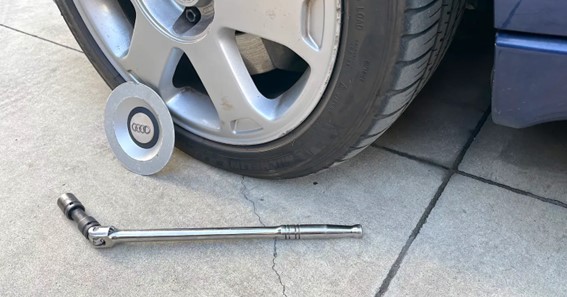Are you curious to know what is a breaker bar? You have come to the right place as I am going to tell you everything about a breaker bar in a very simple explanation. Without further discussion let’s begin to know what is a breaker bar?
In the world of automotive repair and DIY mechanics, having the right tools can make all the difference between frustration and success. Among the essential tools in any mechanic’s arsenal is the breaker bar. Often overlooked and underestimated, this versatile tool holds the key to tackling stubborn and challenging nuts and bolts. In this blog post, we will explore the breaker bar, its features, applications, and why it is a must-have for any serious mechanic or DIY enthusiast.
What Is A Breaker Bar?
A breaker bar is a long-handled, non-ratcheting hand tool designed to provide extra leverage when loosening or tightening fasteners. It consists of a long metal bar with a square drive on one end to accommodate various socket sizes. The opposite end usually features a comfortable handle or grip for easy maneuvering.
Unlike a standard ratchet wrench, a breaker bar does not have a built-in mechanism to turn the fastener continuously. Instead, it relies on the user’s physical force to apply torque to the nut or bolt. This lack of ratcheting action allows the breaker bar to exert significantly more force without the risk of reversing unintentionally during use.
Applications Of A Breaker Bar
- Loosening Stubborn Fasteners: The primary purpose of a breaker bar is to loosen tight or rusted nuts and bolts that are difficult to turn with standard wrenches or ratchets. The long handle and additional leverage allow users to apply greater force without straining their wrists.
- Tire Maintenance: Breaker bars are especially handy for changing tires, particularly when lug nuts are over-torqued or stuck due to rust and corrosion.
- Engine Repairs: During engine repairs or other automotive maintenance tasks, certain fasteners may be exceptionally tight. A breaker bar ensures these fasteners can be safely and efficiently loosened or tightened.
- Suspension Work: Many suspension components require high torque during installation. A breaker bar enables mechanics to achieve the necessary torque without using air tools.
Safety Precautions
When using a breaker bar, it’s essential to prioritize safety to avoid injuries and damage to the equipment. Follow these safety precautions:
- Use Proper Techniques: Always position the breaker bar perpendicular to the fastener to prevent slipping and injuries.
- Don’t Overexert: Avoid applying excessive force on the breaker bar as it may lead to component failure or injury.
- Wear Safety Gear: When working with any tools, including breaker bars, wear appropriate safety gear, such as goggles and gloves, to protect against flying debris.
Conclusion
In the world of automotive repairs and DIY projects, the breaker bar is an indispensable tool, unlocking the potential to tackle stubborn nuts and bolts. With its long handle and non-ratcheting design, the breaker bar provides the leverage needed to overcome resistance and effectively loosen or tighten tight fasteners.
Whether you are an experienced mechanic or a casual DIY enthusiast, having a high-quality breaker bar in your tool collection will undoubtedly make your tasks easier and more efficient. Remember to prioritize safety while using the breaker bar, and you’ll be well-equipped to handle a wide range of mechanical challenges with confidence.
Let’s find out more facts about interesting topics on Turnonx
FAQ
Do You Need A Breaker Bar?
Each tool is designed with a specific objective: breaker bars can “break” tight, frozen, and rusted fasteners free, which otherwise could not be undone by smaller tools like ordinary wrenches and ratchets. When a ratchet can not do the job, a breaker bar is a go-to tool when you need higher leverage and torque power.
What Is The Difference Between Breaker Bar And Wrench?
Breaker bars are specifically designed to break free tight, frozen and rusted fasteners; torque wrenches feature mechanisms which exert exact amounts of torque onto fasteners. These tools are convenient when overtightening is not an option, such as working with spark plugs, lug nuts, engine building or assembly.
Is A Breaker Bar Better Than An Impact Gun?
Breaker bars have long handles and a non-ratcheting mechanism that provide the tool with great torque generation power as well as power multiplication. These two mechanisms deliver more leverage than you would have with an impact tool, and this results in a much more effective tool than any other type of wrench.
What Size Is A Breaker Bar?
As with standard socket sets, breaker bars come in four different drive sizes: ¾-inch, ½-inch, ⅜-inch, and ¼-inch. Most breaker bars have a ½-inch or ⅜-inch head to facilitate removing larger nuts, such as lug nuts.
I Have Covered All The Following Queries And Topics In The Above Article
What Is A Breaker Bar
What Is A Breaker Bar Used For
What Is A Breaker Bar For
What Is A Breaker Bar Ratchet
What Is The Neutral Bar In A Breaker Box
What Is A Breaker Bar?
What Is A Breaker Bar Tool
What Is A Good Breaker Bar
What Is A Neutral Bar On A Breaker Box Panel
What Is A Long Breaker Bar For A Socket
What Size Drive Is On A Breaker Bar
What Is A Bulk Bar Coded Breaker
What Is A Breaker Bar Wrench
What Is A Bar Breaker
What Is A Breaker Bar
Do you need a breaker bar
What is the difference between a breaker bar and a torque wrench
